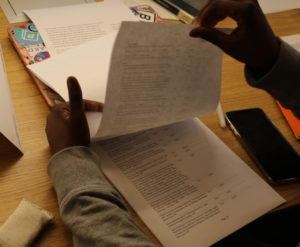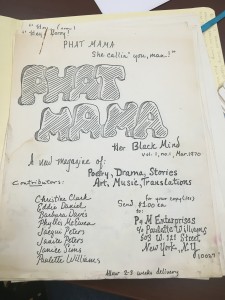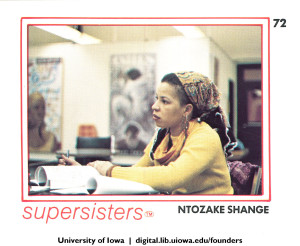I wanted to write a final, reflective blog post surround what I’ve found in the archives, how I’ve come to understand the importance of the archives we have access to and Shange’s contributions to Barnard’s library, and the importance of fair use and copy right laws when it comes to engaging with the materials we use.
I’ve realize through my visits to the archives the incredible courage and confidence it must have taken Shange to leave not just unpublished work or drafts of documents to us, but personal items, in particular personal journals, for public use at an institution. Her decision to do so not only demonstrates her own strength, but also her confidence in the Barnard College community. To trust such a large group of women with this invaluable and private information showcases how much Shange values our college and the education we receive through it. I can’t imagine sharing my personal information in the way that Shange has, and I wish I had the chance to tell her how truly appreciative I am that she has given Barnard this incredible gift. This donation seems to directly embody Shange’s spirit, her generosity, and the courage I hope to one day exude.
During our in-class activity on Thursday, Professor Hall asked us to reflect on what we wish people knew about Shange and what we learned through this course. My answer to both of these question lies within the archives. I wish more people knew about the archives, how accessible they are, and what they have to offer, because through this course, I learned all of this. Prior to taking this course, I had no idea that Barnard was in possession of the archives, that there was so much material in the archives, or that every student has open access to them. I wish more people were aware of them, because I’ve learned so much about Shange, and by extension myself, through self-reflection inspired by Shange, and by visiting and embracing the materials in the archives. I’ve shared this with my close friends, but in the coming semester I am going to make a much larger effort to encourage my peers and members of the various on-campus organizations I’m a part of to visit and use the archives—that’s what they are there for! We cannot truly appreciate the gift that Shange has given us if we aren’t taking advantage of it regularly.
Finally, I wanted to touch on the importance of fair use and copy right, and the need to understand them both. Personally, my concept of these ideas was very surface-level prior to the workshops we had with professionals who deal with these issues every day. The people that produce the works that we are using for this course, our scalar projects and for our educational betterment at large, worked hard to produce the materials they did. It is important to acknowledge and thank the original creators and those that inspire us. I’m grateful that this course gave me a better understanding of these concepts, because these are lessons that I will take with me beyond this class whenever I engage with and use materials that I have not personally created.
For the tech component, I wanted to include a list of Tweets that came out after Shange’s death, of people remembering her spirit and her work. However, there were so many, I would like to invite anyone reading this to check out this link from a website that celebrates and informs women of color, in addition to visiting twitter and filtering for tweets that use the #shange at the end of October.
 e fascinating and only add to my respect for Shange as an artist and activist, I have been more intrigued with items related to her personal life. I’ve enjoyed looking at the items that are more related to her personal life.
e fascinating and only add to my respect for Shange as an artist and activist, I have been more intrigued with items related to her personal life. I’ve enjoyed looking at the items that are more related to her personal life.





